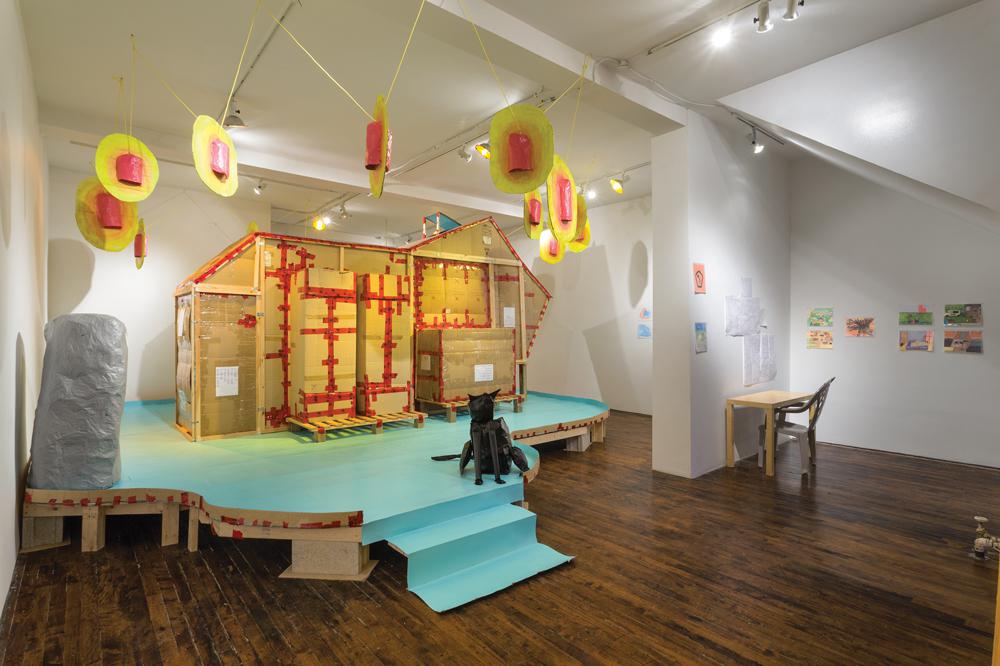As the title suggests, Sherry Walchuk’s “For My Dad” was an intensely personal exhibition. This is typical territory for the recent Concordia MFA graduate: the domestic, architectural vocabulary of all her work is derived, in one way or another, from her parents’ home in Mission, BC, to which she often returns. What was remarkable about the show was how Walchuk balanced such intimate, individual concerns with universal ones—particularly death, and how we deal with it. Here, Walchuk translated her own story into a public, participatory and emotionally vivid experience for others.
The drawings on paper that lined the walls of Articule have the sunny colours and crude flatness of children’s art, and all of them depict some kind of building or domestic setting. Some are maps, some are sketchy blueprints complete with measurements, and some are more abstract, modular variations (“shape chasing,” Walchuk calls them) of pools and RVs, in which the structures become quasi-anthropomorphic characters. It’s clear that the mutually metaphorical relationship between homes and bodies is one of Walchuk’s central preoccupations. In “For My Dad,” home improvement and the kinds of tinkering and puttering that happen in the garage—examples of vernacular creativity—were linked to forms of bodily care and maintenance that happen in hospitals, old-age homes and mental institutions.
The structures in Walchuk’s drawings take three-dimensional form in her inhabitable sculptural installations, all of which are constructed in a makeshift fashion out of cardboard, one-by-twos, papier mâché, tape, and acrylic and oil paint. “For My Dad” contained two doghouses, a tent-like tanning booth and a fridge, but the show was dominated by an almost life-size RV that rests on an elevated deck that’s painted turquoise and ringed by papier-mâché patio lanterns. The pod’s turquoise interior has body-sized niches, which make it a hybrid of a crypt, freezer and igloo. To enter, viewers must remove their shoes and don plastic hospital slippers.
An “idea-map” near the exhibition’s entrance helped decode its contents while offering a glimpse of Walchuk’s process. The RV bears the notes “dad’s house/dad’s body/dad’s coffin” and “ultimate retirement,” and the replica Gyrofocus fireplace (a reference to the earlier use of the same appliance by Geoffrey Farmer) on the other side of the deck is there for “warmth” but also as a “personal incinerator.”
While the slapdash materials of Walchuk’s installation recalled Thomas Hirschhorn, her spatialization of the body’s mortality and decrepitude are closer to Paul Thek—although she’s not as didactic as the former or as ritualistic as the latter. Instead, her work is therapeutic: she presents art as a kind of life-support system. Imagination and everyday making are linked to potential and mobility. A drawn blueprint represents the potential for a home and the ability to imagine being somewhere else. An RV can take you away, but if it gets stuck in place, it can become a tomb.
This is a review from the Fall 2013 issue of Canadian Art. To read more from this issue, please visit its table of contents.

 Installation view of Sherry Walchuk’s “For My Dad” 2013 Cardboard, paint, wood, tape and hardware Dimensions variable / photo Guy L’Heureux
Installation view of Sherry Walchuk’s “For My Dad” 2013 Cardboard, paint, wood, tape and hardware Dimensions variable / photo Guy L’Heureux







